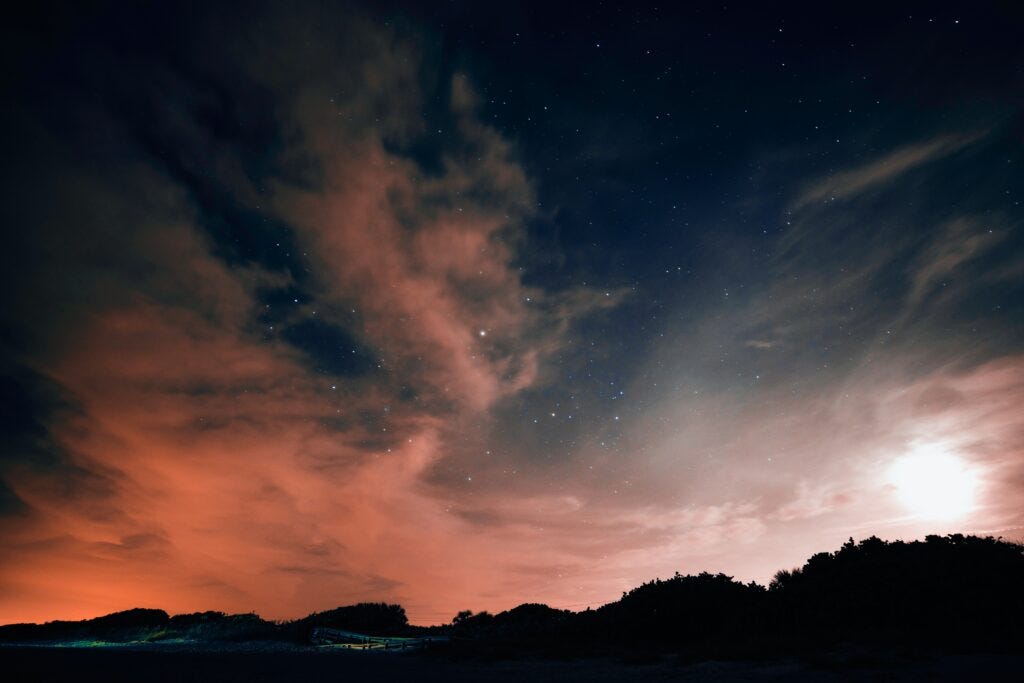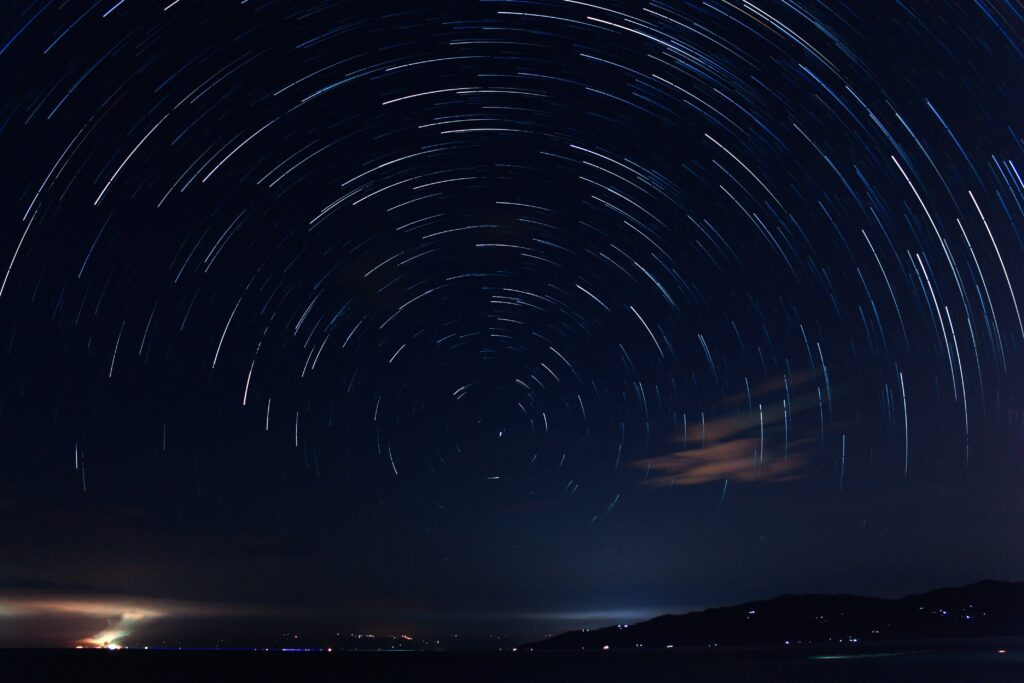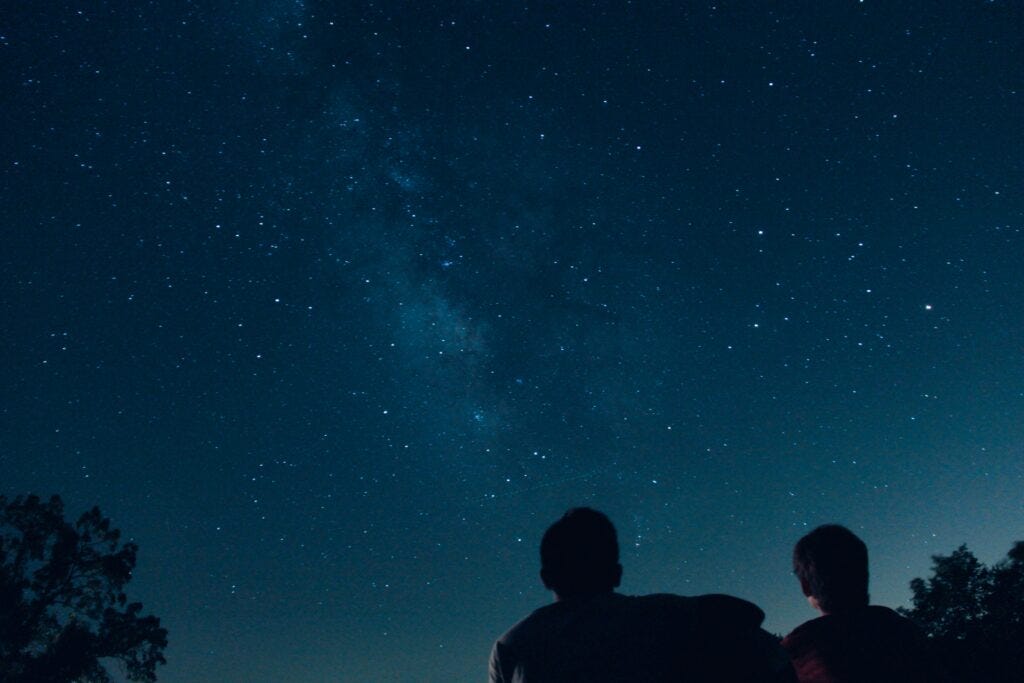Transcript
It’s 5:00 a.m., and I just woke up. I sit up slowly and set my feet on the floor. I gather my phone and glasses and tiptoe out of the bedroom, pulling the door shut ever-so-quiet so I don’t wake Tim. I have an appointment. I’m learning to know a few more stars in the night sky.

In the study I turn the blinds upward so I can see the sky. Today it is a crisp black sea pierced with bright twinkling lights. I glance over the mango tree in the backyard—yes, there’s Venus, bold and brilliant as usual. I pull on my clothes and step outside onto the deck to say hello.
Ah, there she is, glowing bright and oh so beautiful! A rush of gladness, always, when I see Venus. Today I have to stretch my neck a little to see her because she has drifted so far south, with the Sun, and won’t turn around to come back until the solstice [today!].
The ancient people of Mesopotamia knew her as Inanna, Queen of Heaven and Earth, and they told a famous story of Inanna’s trip to the Underworld. Inanna “opened her ear to the great below,” says the four-thousand-year-old text that tells her story. What an evocative way to talk about hearing a call! So Inanna dressed herself in her finest for the big journey. But as she passed the gates to the Underworld, she was forced to give up her possessions one by one—her scepter and her royal crown and her jewels and finally her robe too—until she arrived at the Underworld powerless and naked and alone.
Inanna did figure out how to return to this world, but no one who travels to the world below escapes unscathed, so now she spends part of each year there. Inanna is sometimes the Morning Star and sometimes the Evening Star, and in between she disappears into the land of darkness. But she always returns, rising to glow in the sky once again. She’ll stay in our morning sky until March, and then she will again make her trip to the place of darkness.
Some mornings I play a game with Venus: As the light grows and the Sun rises, how long can I still spot her with my unaided eyes? Here in the tropics the morning light comes fast, and every day the stars wink out within minutes of each other. When all the other stars are gone, swallowed into the bright blue depths of morning, can I still see Venus? I’ve managed to find her some days fifteen or twenty minutes past sunrise.
After I say hello to Venus in the southeast, I turn north and look up, and there are the stars I’ve known since I was a child: the Big Dipper, clear and bright and nearly overhead now in the predawn darkness. My ancestors many centuries ago in Europe thought of the Big Dipper as part of the Great Bear. What I see as the saucepan of the dipper was for them the belly of the bear, and the handle of the dipper is the Great Bear’s tail.
The two leading stars of the Big Dipper’s saucepan point almost straight north, and I follow their line to greet Polaris, the guiding star. Polaris is the one star that looks stationary, always in the same spot, always marking north. Now that I live in the tropics, Polaris hangs much lower in the northern sky than I was used to seeing. And as I watch the stars month by month, I find that they make their slow journeys around Polaris not in the circle I was used to but more like an ellipse. Some rise in the northeast and make a lazy loop toward the south to arrive directly overhead. Then they continue their wide sweep to set again not in the west but in the northwest. When the Big Dipper was near the horizon a couple months ago at this time, it was huge, stretched diagonally. Now it’s a very medium-size dipper overhead.

I pull my jacket tighter. I am lucky to live in a place that is warm enough to watch the stars year-round, but even here, in the week of the winter solstice, I need a fuzzy fleece jacket, zipped all the way up, to stand outside in the darkness before dawn.
I follow the next star cue. The handle of the Big Dipper—or the Great Bear’s tail—curves around in a gentle arc, and if you follow that curve outward with your eyes, you will eventually land on the next brightest star, Arcturus. “Follow the arc to Arcturus” is the old saying for how to find it. The name “Arcturus” means “Guardian of the Bear,” so of course they always go together.
Arcturus twinkles wildly in my sky, creamy yellow or pale orange. Arcturus is a red giant star, which means that he is past his prime—almost twice as old as our Sun. He has used up all his internal fuel and is burning his outer layers now, so he has swollen to many times his original size, like a big glowing puffy star. The red giant stage happens near the end of a star’s life, so we are watching Arcturus in his death throes—maybe only a billion years or so to go before he shrinks into a white dwarf and eventually dies. And his death throes are spectacular: Arcturus shines over a hundred times brighter than our Sun. And Arcturus is a close neighbor in our galaxy, only 37 light-years away, which means only 200 trillion miles, or so.
After gazing at Arcturus for a few moments, my eyes return to the tail of the Great Bear. I follow the arc to Arcturus again then allow my eyes to travel even farther out, about the same distance, along the same curve. And there I find Spica, another bright star, twinkling light blue in the southeast sky. A couple weeks ago when the moon was waning, Spica and that tiny sliver of a moon and bright Venus were dancing past one another, making luminous new designs in the sky every morning.
Spica is actually two stars, a binary system, and those two stars tango around each other so closely that regular telescopes can’t find the space between them. They hug so tight that each of them has turned egg shaped rather than round.
The larger of the two stars is a blue giant, massively hot and bright—about 2000 times brighter than our Sun and tens of thousands of times hotter. Stars like this one use up their internal fuel fast. They burn hot and bright and then die young, usually exploding into a spectacular supernova. Spica’s main star is a baby compared to our Sun—her whole expected lifespan is only about 30 million years, compared to the leisurely long life of 10 billion years that our Sun gets to enjoy. But she will end in glory. She’s poised to go supernova, but I’m not holding my breath because she likely won’t explode for another few million years or so.
The two stars that make up Spica sit only about 250 light-years away—still our close neighbors, astronomically speaking. So the light we see now was born in those stars around the time of the writing of the Declaration of Independence and the Constitution—long ago for us but only a blink of a cosmic eye.
Just thinking about such massive size and distance and explosiveness makes my head spin, and that’s kind of the point. Stepping outside each morning to get to know the stars reminds me just how small we are in the scheme of things. And feeling small in the universe is good for mental health. Every morning when I look up, I take a deeper breath. It feels good to feel small.
We’ve already talked about the scientific research on awe—how filling ourselves with wonder and awe makes people kinder and more generous.
41. Why Is the World So Beautiful?
Transcript “Why is the world so beautiful?” This question inspired a young plant-loving woman of the Citizen Potawatomi Nation to go to college and study botany. Robin Wall Kimmerer tells the story in her luminous book Braiding Sweetgrass—how this question guided her as she earned a PhD and became a professor of botany, and how it guided her too to find …
When we feel wonder and awe, we’re more likely to slow down, more likely to take a moment to help someone else. We become less attached to money. We become more mentally open, and we think more clearly too.
Feeling small in a wondrous universe is like a tune-up for the heart; it makes us better people. Stargazing is good for the heart.

I pivot the other way, toward the southwest. Lots of star friends are glowing in this part of the sky before dawn. Orion with all his bright stars is sinking down in the west right now. The Hawaiian people know him as Wākea, the Sky Father. In the Hawaiian story of the universe, he married Papa, the Earth Mother, and together they brought forth the Hawaiian Islands. The months when Wākea is sailing across the night sky—the rainy months of winter—are the season of Makahiki in traditional Hawaiʻi. It’s a four-month-long holiday of giving thanks for the harvest, when Hawaiians would share stories and perform ceremonies and eat feasts and dance together and pray for abundance and new growth in the new year. It was a time of peace and goodwill and relationship building.
I say hello to Orion, then I start tracing a big circle around him with my eyes. As I’ve been watching the stars over these last months, I’ve been drawing my own connect-the-dots to remember which ones are which. A few months ago I noticed that the brightest stars make a huge halo around Orion, a halo that itself takes up a big chunk of the sky. So every time I see Orion now, I follow that big circle with my eyes.
Following behind Orion, at his heels, is Sirius the Dog Star, the brightest star in the night sky—a star so bright she almost casts a star shadow all by herself. To Hawaiians, Sirius is Kaʻulua, the Queen of Heaven, and she marks the time of the winter solstice because right now she is crossing the highest point in the sky. For me, Kaʻulua has been hidden for months behind the huge monkeypod tree above our cottage, but now she is finally peeking out from behind the canopy, and I feel so happy to see her again. She shines so bright partly because she is one of our closest neighbors—only eight light-years away—and she is traveling toward us. Over the next fifty thousand years or so, she will grow even brighter as she makes her closest approach.
From Kaʻulua or Sirius, my eyes follow a big arc around Orion’s side toward the north, and there above his shoulders is a star that I’m just getting to know: Procyon, the eighth-brightest star in the night sky. Procyon is also a binary star system, with two stars sitting about as far apart as our Sun and the planet Uranus. It turns out that pairs of stars are common in the galaxy—over half of the stars we see are actually couples dancing. Our Sun, as a singleton, is in the minority.
Then I continue in this huge halo around Orion to its next stopping point: Castor and Pollux, the twins of Greek mythology. And here the star story gets really wild because—and I just found this out—Castor is a six-star community, made up of three pairs of stars—two pairs pirouetting around each other and a third pair making a several-thousand-year circle around all of them. The other twin, Pollux, is a single star about twenty light-years closer to us. But together they do look like twins, side by side and about even in brightness.
And together they point toward Capella, far above Orion’s head, about halfway between Orion and the North Star. Capella is becoming one of my go-to stars because they are so bright they are visible even as the morning light grows in the east, even after most of the other stars have winked out. Capella is a group of four stars, two pairs dancing around each other.
Long ago Capella’s four stars made up the brightest star in the night sky. This was around two hundred thousand years ago, when our earliest mothers and fathers on Earth, the first modern humans, were watching the sky. Capella was the star closest to north in their sky, so they likely walked between rivers and across savannas using Capella as their guide.
But the cosmic neighborhood has changed a lot since then. Some star people have died and others been born. And everybody—every star and every planet—is always on the move, forever a migrant. In the two hundred thousand years since Capella was the brightest, even the tilt and the orbit of our own planet have changed. So for us Capella lies far from true north and is the sixth-brightest star in the sky.
As I contemplate the vast distances between the stars, I think about a book I’m reading by the Aboriginal author Tyson Yunkaporta. Like most of my culture, I was brought up thinking of those trillions of miles between stars as empty space. Cosmologists tell us that interstellar space is actually full of particles and background radiation and mysteries like dark matter and dark energy. But that story doesn’t tend to percolate into our everyday experience. Most of the time, we look up and think of the space between stars as a dark vacuum, lifeless and empty.

But Tyson says that to people in his culture, those spaces between stars are alive, just as the soil on Earth between, say, two trees is alive. He writes, “There are living rocks up there as there are down here, and the dark spaces between the stars are not a vacuum, but solid lands that have mass and sentience. . . .” He says his people noticed long ago that the spaces between the stars exert force on the stars; those spaces are “living country,” he says.
To focus only on the stars in the sky as our points of interest, Tyson says, is to miss out on the whole picture. “The real understanding,” he writes, “comes in the spaces in between, in the relational forces that connect and move the points.” This is a principle of all kinds of knowing among his people. Pay attention to the spaces between, he says, to the interactions between the parts. He writes, “Information is in each part, but the knowledge lies in the connections between them.”
And I think about how everything is in relationship to something else. And through those linkages everything is connected to everything else. Nothing and no one is isolated. Even 200 trillion miles of space are not empty. We are small in the universe, and yet we are connected up with all of it. We do not sit outside as observers. We are in the thick of it—making and being made, creating and being created.
What we do here matters. We shape our connections, and those connections act upon other connections. Our reach is larger than we know. It stretches into those spaces we cannot see, those living spaces that clasp all beings in webs of connection.
So sinking into wonder and awe and cleansing the heart become especially important when there is a lot of pain on Earth, as there is now. Cleansing the heart helps keep us from responding in unhelpful ways, whether we’re tempted to give up in despair or collapse into powerlessness or react in anger in a moment when anger only inflames. Cleansing the heart with wonder and awe can keep us focused on what we can do.
We may not be able to do big things to make peace in other parts of the world, but there is one thing we can always do: we can always bring the work home. We can always keep opening our own hearts. Always making room for peace within us and around us. Always cultivating a spirit of welcome and inclusiveness. Always extending that spirit of welcome to others.
So at this turning of the year, as we nourish our connections with others—those we hold close and those who are far away—it’s a good time to feel held by these connections, even the ones who are trillions of miles away twinkling in the night sky. All of them help us know where we are and who we are, and all of them can help us keep our hearts in a good place.
The Hawaiians during the festival of Makahiki wish each other new life in the new year. So at this turning of the year, I’m wishing for all of us peace and blessings and the wonder of new life that unfolds in ways we might not even imagine.
Happy Solstice to each of you, and happy holidays!
For digging deeper
Phone apps that show the names of the stars are enormously helpful if you, like me, forget the names or locations and need to be reminded almost every time. SkySafari is one app; SkyView Lite is another. Just point the phone and find the name of the star or planet or constellation.
The Sumerian text that tells the story of Inanna’s descent to the Underworld is available online at the Internet Archive: Diane Wolkstein and Samuel Noah Kramer, Inanna, Queen of Heaven and Earth: Her Stories and Hymns from Sumer (New York: Harper & Row, 1983), 52.
The Cree people know the Great Bear as Ochek, the Fisher, a weasel-like animal. Long ago, when summer disappeared (probably during the last ice age), all the animals got together to figure out how to bring summer back. They chose the fisher to go find it. Fisher succeeded, and afterward he escaped to the heavens. See Kelly Boutsalis, “Teaching Indigenous Star Stories,” The Walrus, Feb. 12, 2021.
Red giant stars as they expand can “eat” any planets that are caught too close, and earlier this year astronomers caught one red giant in the act. See “Red Giant Caught Devouring a Planet for the First Time,” LabOnline, May 8, 2023.
The Stardate radio program has a whole list of episodes on Spica. You can find it online here.
I learned about Hawaiian knowledge of Orion from “Measuring the Elements: A Lecture by Lilikalā K. Kame'eleihiwa.” Hawaiians tracked the beginning of the winter holiday with the rising of the Pleiades in the evening sky. See Wayne Smith, “Ancient Hawaiian Celebration of Makahiki Tied to the Stars,” February 2000. For music and dance from contemporary Makahiki celebrations in the Waimea Valley on Oahu, see “Makahiki Festival” at the Waimea.net website.
Tyson Yunkaporta’s words come from Sand Talk: How Indigenous Thinking Can Save the World (New York: HarperCollins, 2020).














Share this post